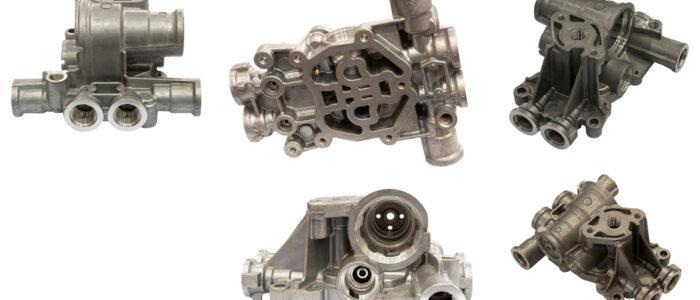Modulus Metal has ISO / IATF certified die casting supplier base, mainly in aluminum high pressure die casting, and our partner suppliers are experienced in automotive, aerospace, agricultural and industrial machinery manufacturing for many years.
Production capabilities : Up to 10 kg /piece
Quantity: Mainly high volumes of production due to tooling cost
HIGH PRESSURE DIE CASTING
The method
In PRESSURE DIE CASTING, molten metal is fed under high pressure into a metal die via a sprue and runner system, and pressure is maintained during solidification. The die halves are then opened, and the casting is ejected. Because of the high pressures involved, the two die halves are held together with a strong force and secured with toggle clamps. The dies are water-cooled and carefully machined from heat-resistant steel. They frequently have multiple moveable pieces and are thus complex and costly.

Process characteristics: Primary shaping processes , Discrete
Design guidelines: High shape complexity
Technical Information:
Applicable for lower melting point alloys (Tm<927°C), i.e. aluminum and zinc alloys
The Ferro Die method can be used to manufacture high melting point alloys. The thicknesses of the walls should be as even as feasible. Surface detailing is superb. Die castings aren’t known for their metallurgical robustness. Castings have gas and shrinkage porosity because of turbulent filling and quick cycles.
Typical Applications
Automotive applications: carburetor and distributor bodies, clutch and gearbox housings; electrical applications: motor frames and cases, switchgear housings; general applications: pulleys, rotating parts, record player parts, etc.
FERRO DIE CASTING
The method
The FERRO DIE CASTING technique is similar to the cold chamber die casting method, but it has been modified to produce ferrous castings by the use of specific die inserts.
A molybdenum-based alloy known as TZM is used, which has a strong resistance to thermal fatigue and can thus endure pouring temperatures of up to 1600 degrees Celsius. Because of its high cost, this alloy is only used in die parts that come into contact with hot metal.
Due to the high conductivity of the die inserts, the casting surface has a highly fine chilled microstructure. There is no porosity on the surface (1 percent throughout the casting).
Process characteristics: Primary shaping processes, Discrete
Design guidelines: Shape complexity can be high.
Technical information
Used for high melting point alloys: tool steels, carbon steels (<0.5%C), stainless steels (e.g. 302, 316, 410, 431), copper, cobalt and nickel alloys (air melting grades. Standard die casting is more cost-effective for aluminum and zinc alloys. The thickness of the walls should be as uniform as feasible. The surface detail is superb. A draft angle of 5 degrees is required to ensure the component’s release from the die.
Typical uses: Difficult-to-machine ferrous alloys.
Other Types of Die Casting Modulus Metal serves:
- Low Pressure Die
- Gravity Die
- Squeeze






